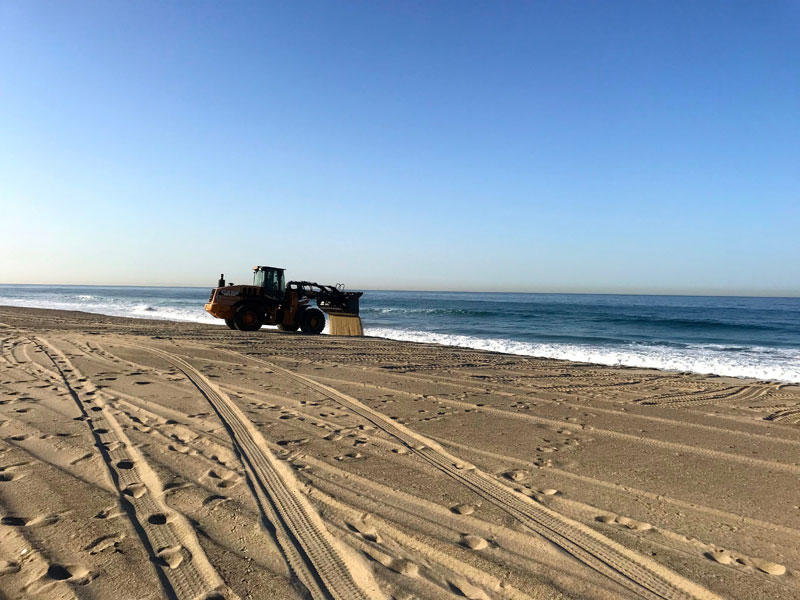Beach renourishment. Photograph: © SAF — Coastal Care.
Excerpts;
Beach communities that rely on dredging to replenish protective dunes object to expanded federal protections.
Environmental advocates are pushing back with warnings about the possible ecological damage from beach replenishment projects that they call sand mining…
Also of Interest:
The sands of time; The New York Times (12-15-2017)
Human intervention to control beach depth is often futile. Repeated studies have found that sand pumped onto beaches in order to protect coastal property may be washed out by a storm or two. These beaches commonly lose all the new sand in five years or so…
A Beach Project Built on Sand; By Robert S. Young, PhD, in The New York Times (08-22-2014)
Coastal Barrier Resources System: Testimony of Robert S. Young, PhD; (04-07-2014)
A look at the billions of dollars behind beach renourishment: Is it worth it? WMBF (10-15-2018)
“A Never-Ending Commitment”: The High Cost of Preserving Vulnerable Beaches; ProPublica (09-27-2018)
The U.S. government pays to dump truckloads of sand onto eroding beaches, in a cycle that is said to harm ecosystems and disproportionately benefit the rich…
Beach rebuilding efforts won’t stave off climate change impacts forever; Guardian UK (09-20-2018)
Can Adding Sand to Beaches Save Them? How Stuff Works (04-13-2018)
The question is, can beach nourishment keep up with the ever-increasing forces of climate change or, like Sisyphus forever pushing his boulder up the hill, is adding sand to beaches an expensive, temporary fix to a long-term problem?..
Is pumping more sand onto NC beaches causing deadly currents?; The News & Observer (08-30-2018)
A growing number of scientists and coastal engineers worry that there’s a serious downside to beach nourishment: Unnaturally altered beaches could pose an elevated risk of injury to the very tourists that sand replenishment was meant to attract…
Widening beaches might bring more hazards, researchers say; Sun Sentinel (04-04-2018)
Widening beaches might be linked to an increase in accidents, according to new data. The number of ocean rescues spikes after beaches are buffed up, according to the data published in the Journal of Ocean Research…
Factbox: Sifting Through U.S. Beach Sand Numbers; Reuters (02-16-2018)
Sea level rise has already sunk Carolinas beach property values — by $1.6 billion, study finds; News & Observer (07-25-2018)
Sea levels are rising and the southeast has already lost billions in property value, a recent study shows. Scientists have found $7.4 billion was lost in home values across North Carolina, South Carolina, Virginia, Georgia and Florida because of sea level rise flooding from 2005 to 2017…
Coastal geologist criticizes beach renourishment efforts; By Robert S. Young, PhD; The State (08-17-2016)
Rob Young, who heads the Program for the Study of Developed Shorelines at Western Carolina University, said the government is subsidizing coastal development with renourishment money – and that’s costing taxpayers. Communities across the country have spent millions of dollars renourishing beaches. Those efforts encourage people to rebuild after every major hurricane…
Palm Beach Mid-Town Dredge Project, A Youtube Video (02-04-2015)
“Beach nourishment projects like this have become commonplace along the US East and Gulf Coasts. These projects have immediate environmental impacts through burial of nearshore habitat and increased turbidity during project placement.The cumulative environmental impacts of doing this repeatedly on the same beach while conducting projects from Maine to Texas is unknown. But, we should be concerned. ” —Robert S. Young, PhD, Director, Program for the Study of Developed Shorelines, Professor, Coastal Geology, Western Carolina University
“Seawalls Kill Beaches,” Open Letters by Warner Chabot And Rob Young; (10-03-2014)
The only answer to rising seas is to retreat; By Orrin H. Pilkey & Keith C. Pilkey; The News & Observer (10-18-2017)
Except for the timing, there is no controversy among scientists regarding sea level rise. Defending the coast and holding the shoreline in place ultimately will be futile. With a three-foot or a six-foot sea level rise, we will retreat, probably beginning within the next 50 years…
Sand, Rarer Than One Thinks: A UNEP report (GEA-March 2014)
Despite the colossal quantities of sand and gravel being used, our increasing dependence on them and the significant impact that their extraction has on the environment, this issue has been mostly ignored by policy makers and remains largely unknown by the general public.
In March 2014 The United Nations released its first Report about sand mining. “Sand Wars” film documentary by Denis Delestrac – first broadcasted on the european Arte Channel, May 28th, 2013, where it became the highest rated documentary for 2013 – expressly inspired the United Nations Environment Programme (UNEP) to publish this 2014-Global Environmental Alert.
Sand Wars, An Investigation Documentary, By Award-Winning Filmmaker Denis Delestrac (©-2013)
“Sand is the second most consumed natural resource, after water. The construction-building industry is by far the largest consumer of this finite resource. The traditional building of one average-sized house requires 200 tons of sand; a hospital requires 3,000 tons of sand; each kilometer of highway built requires 30,000 tons of sand… A nuclear plant, a staggering 12 million tons of sand…”—Denis Delestrac -(©-2013)









